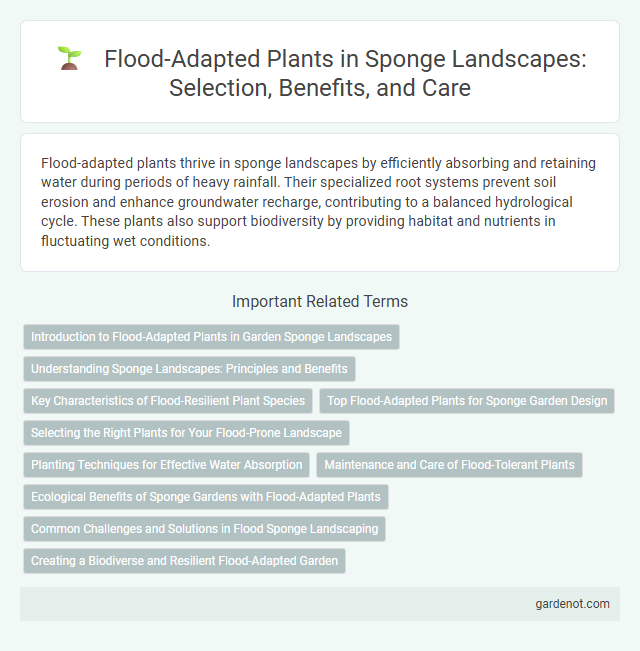Flood-adapted plants thrive in sponge landscapes by efficiently absorbing and retaining water during periods of heavy rainfall. Their specialized root systems prevent soil erosion and enhance groundwater recharge, contributing to a balanced hydrological cycle. These plants also support biodiversity by providing habitat and nutrients in fluctuating wet conditions.
Introduction to Flood-Adapted Plants in Garden Sponge Landscapes
Flood-adapted plants thrive in garden sponge landscapes by tolerating periodic waterlogging and enhancing soil absorption. Species such as sedges, rushes, and certain wetland grasses improve water retention and reduce runoff, promoting natural flood mitigation. Incorporating these plants supports ecosystem resilience and sustains biodiversity in flood-prone areas.
Understanding Sponge Landscapes: Principles and Benefits
Flood-adapted plants play a crucial role in sponge landscapes by enhancing water infiltration and reducing surface runoff during heavy rainfall. Species such as sedges, rushes, and native wetland grasses possess root structures that improve soil permeability and resilience against prolonged flooding. Integrating these plants into sponge landscapes supports natural water retention, mitigates flood risks, and promotes ecosystem health.
Key Characteristics of Flood-Resilient Plant Species
Flood-resilient plant species exhibit key characteristics such as aerenchyma tissue development, enabling efficient oxygen transport to submerged roots, and the ability to tolerate prolonged periods of soil saturation without root rot. These plants often possess adventitious roots and the capacity for anaerobic respiration, which support survival during extended flooding. Morphological adaptations like flexible stems and rapid shoot elongation facilitate recovery and growth in fluctuating water conditions typical of sponge landscapes.
Top Flood-Adapted Plants for Sponge Garden Design
Top flood-adapted plants for sponge garden design include species such as Bald Cypress (Taxodium distichum), Swamp Milkweed (Asclepias incarnata), and Pickerelweed (Pontederia cordata), which thrive in wet conditions and help absorb excess water. These plants feature deep root systems that improve soil permeability and reduce surface runoff, enhancing the landscape's natural flood management. Incorporating flood-tolerant grasses like Blue Flag Iris (Iris versicolor) and soft rush (Juncus effusus) supports water filtration and creates a resilient, sustainable sponge landscape.
Selecting the Right Plants for Your Flood-Prone Landscape
Selecting flood-adapted plants such as pickerelweed, swamp milkweed, and bald cypress enhances resilience and water absorption in sponge landscapes. These species thrive in saturated soils, reducing erosion and improving water quality through natural filtration. Incorporating deep-rooted wetland plants stabilizes flood-prone areas, promoting ecosystem balance and mitigating stormwater impact.
Planting Techniques for Effective Water Absorption
Flood-adapted plants thrive when integrated using deep planting techniques that position roots below the water table, enhancing water absorption and preventing soil erosion. Layering organic mulch around the root zone improves moisture retention and promotes microbial activity essential for nutrient cycling in saturated soils. Strategic spacing ensures optimal airflow and reduces competition, enabling robust growth in fluctuating wet conditions typical of sponge landscapes.
Maintenance and Care of Flood-Tolerant Plants
Flood-tolerant plants require minimal maintenance due to their ability to thrive in waterlogged conditions, reducing the need for frequent watering and soil amendments. Regular inspection of root health and removal of debris prevent fungal growth and root rot, ensuring plant longevity. Applying mulch helps retain soil stability and nutrient levels, supporting the plant's resilience during prolonged flooding events.
Ecological Benefits of Sponge Gardens with Flood-Adapted Plants
Flood-adapted plants in sponge landscapes play a crucial role in enhancing water absorption and reducing surface runoff, thereby mitigating flood risks. These plants improve soil structure and promote microbial activity, which boosts nutrient cycling and supports diverse ecosystems. Their ability to thrive in saturated conditions helps maintain habitat stability and water quality during heavy rainfall events.
Common Challenges and Solutions in Flood Sponge Landscaping
Flood-adapted plants in sponge landscape designs face common challenges such as prolonged waterlogging, poor soil aeration, and nutrient leaching, which can stress root systems and reduce plant vitality. Solutions include selecting native hydrophytic species with aerenchyma tissues for efficient oxygen transport, implementing raised beds or mounded areas to improve drainage, and using organic amendments to enhance soil structure and nutrient retention. Integrating these strategies optimizes plant survival and ecosystem resilience in managed flood-prone environments.
Creating a Biodiverse and Resilient Flood-Adapted Garden
Flood-adapted plants such as pickerelweed, blue flag iris, and swamp milkweed thrive in saturated soils, enhancing a sponge landscape's ability to absorb excess water. These species support local wildlife by providing essential habitats and promote a resilient ecosystem capable of withstanding frequent flooding. Integrating diverse flood-tolerant vegetation strengthens soil stability and reduces erosion, contributing to a sustainable and biodiverse garden environment.
Flood-adapted plant Infographic

 gardenot.com
gardenot.com